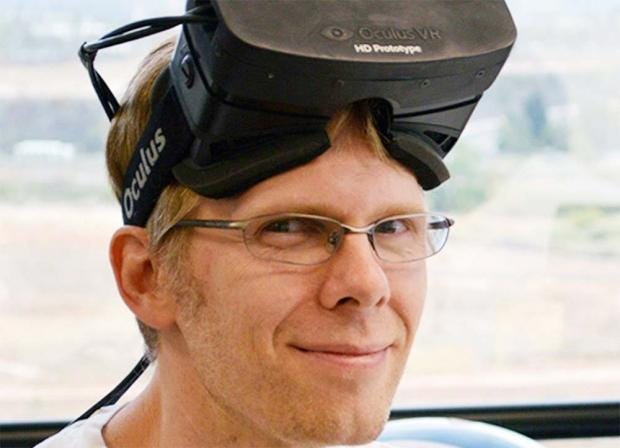Masters of Disruption: How the Gamer Generation Built the Future [6]
For the engineers of the metaverse, all roads lead to the Holodeck.
This post is part of a longform project I’m serializing exclusively in my newsletter, Disruptor. It’s a follow-up to my first book, Masters of Doom: How Two Guys Built an Empire and Transformed Pop Culture, and it’s called Masters of Disruption: How the Gamer Generation Built the Future. To follow along, please subscribe to Disruptor and spread the word. Thanks!
One night in 1987, John Carmack saw the ultimate game. It occurred in the opening episode of a new television series, Star Trek: The Next Generation, when the captain visited the ship’s Holodeck, a futuristic device that could simulate immersive environments for relaxation and entertainment. In this case, the door opened to reveal a tropical paradise. Carmack was intrigued. This was the virtual world. It was just a matter of finding the technology to make it happen.In this passage from my book Masters of Doom: How Two Guys Transformed Pop Culture, I wrote about the impact of the Holodeck on id Software’s co-founder and lead programmer John Carmack.
For Carmack, the Holodeck didn’t feel like a dream. It felt like an imperative. He told me as much one afternoon in 2000, as we talked in a hallway at QuakeCon, the annual convention for fans of id’s classic shooter, Quake. He had thick glasses, wispy sandy blonde hair, and wore a t-shirt of a smiley face with a bloody bullet hole through the forehead.
“Where we’re eventually going is towards the Holodeck,” he said, “The Holodeck is the ultimate game simulation. You call up whatever you want to do and put yourself into it and it’s perceived as real. That’s what I look at as the benchmark, where you want everything to become more and more flexible and powerful and believable. You can call up an arbitrary environment and then interact with it in some way.”
In the recent posts of my follow-up project, Masters of Disruption: How the Gamer Generation Built the Future, we’ve explored the rise and future of the metaverse with Carmack, his ex-partner John Romero, and one of their influential progeny, Alexis Ohanian, co-founder of Reddit.
Twenty-five years after they watched the Holodeck in the episode “Encounter at Farpoint,” the fantasy of stepping into a virtual world is becoming a reality - minus Captain Picard’s natty white suit and black bow tie. While Mark Zuckerberg recently declared that Facebook would become “a metaverse company,” the real seeds are coming from gamers. Minecraft, Fortnite, Roblox, and Rec Room (which I’ll be taking a deeper dive into in later posts) are pointing the way to our virtual future, just as id’s early shooters such as Doom did two decades ago.
Looking back at my original interviews with Carmack now, it’s interesting to note what he thought would be the enabling technologies of Holodeck-like experience. The significant points are going to be at transitions of I/O devices,” he told me in 2000, “like bringing a mouse into things was a signicant transition. Small video cameras are going to probably going to be the next significant step in user interactivity. It’s not clear exactly how they’re going to be used, but it’s important because they’re cheap and they are also starting to become pervasive.”
“It’s an agglomeration gravitational pull effect: when there's value, it begets more value.”
He was right, of course. Today, most of us are carrying video cameras around in our pockets. But as he told me recently, the Holodeck - with its range of entertainment and experiences - still points the way to the future.
“You need a kernel of value for people to be excited about your project and to gravitate around it,” Carmack told me recently, “It’s an agglomeration gravitational pull effect: when there's value, it begets more value. And then you get, it expands out into this Metaverse-like world, where eventually you've got millions of people doing interesting things. Facebook now in many ways is struggling to get its product market fit because it was designed to be this generic thing rather than designed to make something awesome from the beginning.”





